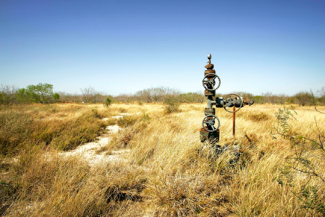The past year saw NETL achieve a number of critical successes to advance initiatives and technologies that will lower atmospheric levels of methane, a potent greenhouse gas (GHG), while ensuring a safe, reliable and resilient natural gas supply chain for U.S. consumers.
NETL’s Methane Mitigation Technologies Program is focused on developing accurate, cost-effective and efficient technology solutions and best practices to identify, measure, monitor and eliminate methane emissions.
NETL researchers took steps forward in these programs areas — (1) methane mitigation to facilitate a “leak-tight” natural gas value chain; (2) methane quantification to develop technologies to reduce or eliminate chronic emissions from natural gas infrastructure; (3) identification and characterization of undocumented orphaned wells; (4) elimination of flaring and non-safety-related venting of natural gas by converting it into sustainable fuels and chemicals; and (5) mitigation of greenhouse gas emissions from liquefied natural gas production and transport infrastructure.
Progress is crucial. Methane, the primary component in natural gas, is the second most abundant anthropogenic (originating in human activity) GHG after carbon dioxide. According to the U.S. Environmental Protection Agency (EPA), carbon dioxide accounts for 65% for global GHG emissions. Methane accounts for about 16% of global emissions, but it is more than 28 times as potent as carbon dioxide at trapping heat in the atmosphere.
In 2023, NETL agreed to help lead a $1.3 billion interagency initiative to reduce methane emissions across the U.S. oil and natural gas industry. The EPA ranks oil and natural gas operations as the nation’s largest industrial source of methane emissions, which also contain harmful air pollutants such as volatile organic compounds and benzene, a carcinogen.
The Lab’s pivotal role in reducing methane emissions from the oil and gas sector was outlined in a memorandum of understanding (MOU) among the EPA’s Office of Air and Radiation, the U.S. Department of Energy’s Office of Fossil Energy and Carbon Management and NETL. Highlights from MOU include:
- NETL has agreed to partner with the EPA by executing and participating in the agency’s Methane Emissions Reduction Program. NETL will leverage its core competencies, capabilities, resources and expertise to quantify and reduce methane emissions from inefficient and leaking oil and gas operations.
- Initial steps will aim to address methane emissions from marginal conventional wells — those that produce less than 15 barrels of oil per day or less than 90,000 cubic feet of natural gas per day. The U.S. Energy Information Administration estimates there are more than 695,000 marginally producing wells in the United States.
- NETL will manage a grant program that will provide up to $350 million in financial and technical assistance to eligible states for mitigating methane emissions from low-producing, conventional wells by permanently plugging wells voluntarily identified by owners/operators.
- The Lab will equip the oil and gas industry with the computational tools and other assistance to develop a standardized approach for measuring emissions.
In addition to active wells, there are hundreds of thousands of undocumented orphaned oil and gas wells in the United States. NETL continued to advance efforts to identify and characterize these wells to assist local, state and federal agencies in plugging and abandoning activities. Developments in this area included:
- NETL researchers visited Kentucky’s Daniel Boone National Forest to verify locations of abandoned wells. Such field visits find abandoned wells that were drilled before environmental laws were enacted and continue to emit methane.
- Techniques to find abandoned wells, including drone magnetic surveys and light detection and ranging (LiDAR) technology, continued to be refined by NETL.
- Natalie Pekney, Ph.D., an NETL environmental engineer leading research to mitigate methane emissions from abandoned oil and gas wells, received an Arthur S. Flemming Award, one of the nation’s top honors presented to federal employees.
Also in 2023, NETL’s pipeline sensor team tested of an extensive collection of fiber optic sensor and surface acoustic wave sensor technologies for natural gas pipeline monitoring that can help ensure safer and more secure natural gas pipeline delivery and mitigate methane emissions. Optical fiber sensors are small, lightweight, can endure high temperatures and pressures, and are immune to electromagnetic interference.
NETL is a U.S. Department of Energy national laboratory that drives innovation and delivers technological solutions for an environmentally sustainable and prosperous energy future. By using its world-class talent and research facilities, NETL is ensuring affordable, abundant and reliable energy that drives a robust economy and national security, while developing technologies to manage carbon across the full life cycle, enabling environmental sustainability for all Americans.




